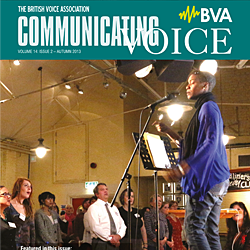About the Association
Archived newsletter articles
Vocal Anatomy and Physiology for Performers and their Teachers
Tuesday 19 September 2006, Glenister Seminar Rooms at Charing Cross Hospital, London
British Voice Association event report – a personal perspective by singing teacher Sue Anderson
I found the Glenister Seminar Rooms at Charing Cross hospital after a pleasant stroll across the cemetery from Barons Court underground station. The rooms are opposite the main building of the hospital, but set apart from it, and almost within the cemetery itself. I don't know if I am rashly generalising from far too little evidence, but cemeteries and hospitals often seem to be found insensitively close to one another! To my far from encyclopedic knowledge this is a new venue for the BVA, and on this occasion we were using the well-equipped lecture theatre and a flexible suite of ground-floor rooms. The rooms were opened up in the morning for coffee and lunch, during which they also housed displays of appropriate anatomical models and charts from some of our sponsors. In the afternoon they were divided into three for the workshops. The forty delegates included a majority of singers/singing teachers, with some vocal coaches, directors and actors. Although many people came from London and the South East, two had flown over from Jersey, because they could not get this sort of study day at home! It was particularly gratifying to welcome some new members for whom this was their first BVA event.
The day began with an introduction to the concepts of anatomy from Declan, an orientation session in which he led us gently through the terminology (mainly derived from Greek and Latin) that is so familiar to the medics, but which is not necessarily everyday language for performers. The contrast was made between 'gross anatomy', referring to that which is visible to the naked eye, and 'microscopic anatomy' or histology. Ann Sandison spoke about the complex field of histology and histopathology, moving between the main systems of the body and the microscopic examination of the different types of tissue within these systems. Although fascinating, with multi-coloured slides enlivening the entertaining delivery of Dr Sandison, I'm afraid that I was left a little confused, and failed to find a link in my mind between the two branches of anatomy that would be relevant to performers and their teachers.
After the morning coffee break we returned to the more clear-cut territory of 'the Anatomy of Voice', with Guri Sandhu, ENT surgeon at Charing Cross Hospital, clearing up some popular misconceptions about sinuses, tonsils and the soft palate in the process. At the end of his handout two slides tantalisingly showed the lungs and the diaphragm, but this is about as close as we came during the day to the consideration of the anatomy and physiology of breathing. Whether this was by deliberate design, or just the inevitable result when 3 or 4 eminent ENT surgeons are gathered together, I'm not sure. The second half of this presentation, by Christella Antoni, came as quite a surprise, as she moved well away from anatomy and physiology into an illustrated guide of the application of anatomy and physiology as found in the Estill Model of singing. I personally think that it would have been so much more useful if Christella had stayed with the timetable and had used her refreshing style of delivery to share with us her professional expertise as an SLT. It was abundantly clear in the afternoon workshop sessions on endoscopy of the larynx that she has great knowledge and understanding, and is obviously a valued member of the Charing Cross Voice Clinic.
The very full morning concluded with Meredydd Harries speaking with characteristic enthusiasm and vitality about 'comparative anatomy'. My awe about the diversity of nature was reaffirmed (David Attenborough move over!), but I wonder whether a more relevant 'comparative anatomy' might have been a comparison of laryngeal development and change through babyhood, infancy, and adolescence, to adulthood, menopause and antiquity. But I am beginning to sound very grumpy - the session itself was actually very entertaining and thought provoking as we were reminded yet again that 'architecture reflects function'.
The afternoon began with Julian McGlashan giving a very informative talk about the physiology of the voice, covering a brief introduction to sound waves (reminding us that sound is a transfer of energy, not of the air itself), the structure of the vocal folds, changes in register and a brief glance at articulatory mechanisms. In response to a question about register changes, he showed part of the very old but irreplaceable video by Vennard of the construction of a larynx from its component parts, and continued through the video to the very clear demonstration of how the movement pattern of the vocal folds changes as vocal fold mass and frequency are varied; 'register' changes are actually caused by clear physiological changes.
We then divided into groups for the three workshops, which gave everyone a good opportunity to clear up any misunderstandings in more informal discussion. In my group we began by handling several of the anatomical models provided by Adam,Rouilly, thinking of the virtues of each model from a singing teacher's perspective. Guri Sandhu and Christella Antoni provided an excellent endoscopy session, in which volunteers were endoscoped using either a flexible or a rigid strobe. I suspect that most singers are nervous about what may be revealed about the state of their larynxes (I have yet to volunteer for this activity!), and Guri and Christella calmly and expertly focused our attention on the relevant structures and actions. In our final workshop, 'Surface anatomy', we felt or palpated our own and each other's throats, gradually gaining confidence under the reassuring guidance of Declan and Meredydd.
The afternoon began with Julian McGlashan giving a very informative talk about the physiology of the voice, covering a brief introduction to sound waves (reminding us that sound is a transfer of energy, not of the air itself), the structure of the vocal folds, changes in register and a brief glance at articulatory mechanisms. In response to a question about register changes, he showed part of the very old but irreplaceable video by Vennard of the construction of a larynx from its component parts, and continued through the video to the very clear demonstration of how the movement pattern of the vocal folds changes as vocal fold mass and frequency are varied; 'register' changes are actually caused by clear physiological changes.
We then divided into groups for the three workshops, which gave everyone a good opportunity to clear up any misunderstandings in more informal discussion. In my group we began by handling several of the anatomical models provided by Adam Rouilly, thinking of the virtues of each model from a singing teacher's perspective. Guri Sandhu and Christella Antoni provided an excellent endoscopy session, in which volunteers were endoscoped using either a flexible or a rigid strobe. I suspect that most singers are nervous about what may be revealed about the state of their larynxes (I have yet to volunteer for this activity!), and Guri and Christella calmly and expertly focused our attention on the relevant structures and actions. In our final workshop, 'Surface anatomy', we felt or palpated our own and each other's throats, gradually gaining confidence under the reassuring guidance of Declan and Meredydd.
The final full session of the day was entitled 'What can go wrong?' and once again we were looking at videos of larynxes, with cysts, nodules and various other infirmities. Meredydd emphasised that although both cysts and nodules make the vocal folds function less efficiently because they stop the folds meeting properly, causing a breathy sound and vocal fatigue, it was very important to differentiate between the two. He said that nodules are bilateral swellings that very rarely need surgery; they are now dealt with by looking at the speaking (and singing) technique of the patient with an SLT to remove the cause of the nodules. However cysts are often removed by surgery, and Meredydd advised us that it was important to re-start gentle use about 2 weeks after any surgery involving the vocal tract, so that the scar tissue remained flexible. The following question and answer session prompted a four-way discussion about whether the surgeons present preferred to use laser or 'metal' tools.
This discussion brought home to me what a fantastic line-up of speakers had been gathered together for the day by Declan and Guri. Although I may have expressed some personal reservations about the content of the day, the event certainly provided a stimulating and thought-provoking learning environment for the delegates. Jackie Ellis was also with us for the day, quietly doing the unsung administration without which no BVA study day is possible.
The event was organised by Declan Costello and Gurpreet Sandhu and led by Declan Costello.
More archived content online
Disclaimer
Neither the British Voice Association nor the Editor can be held responsible for errors or any consequences arising from the use of information contained in its newsletters (or extracts from its newsletters published online); the views and opinions expressed do not necessarily reflect those of the British Voice Association (BVA) or the Editor, neither does the publication of advertisements constitute any endorsement by the BVA or Editor of any products or services featured.

 Join us Now!
Join us Now! our newsletter
our newsletter free voice care leaflets & information – download here
free voice care leaflets & information – download here Help our work by donating while you shop
Help our work by donating while you shop